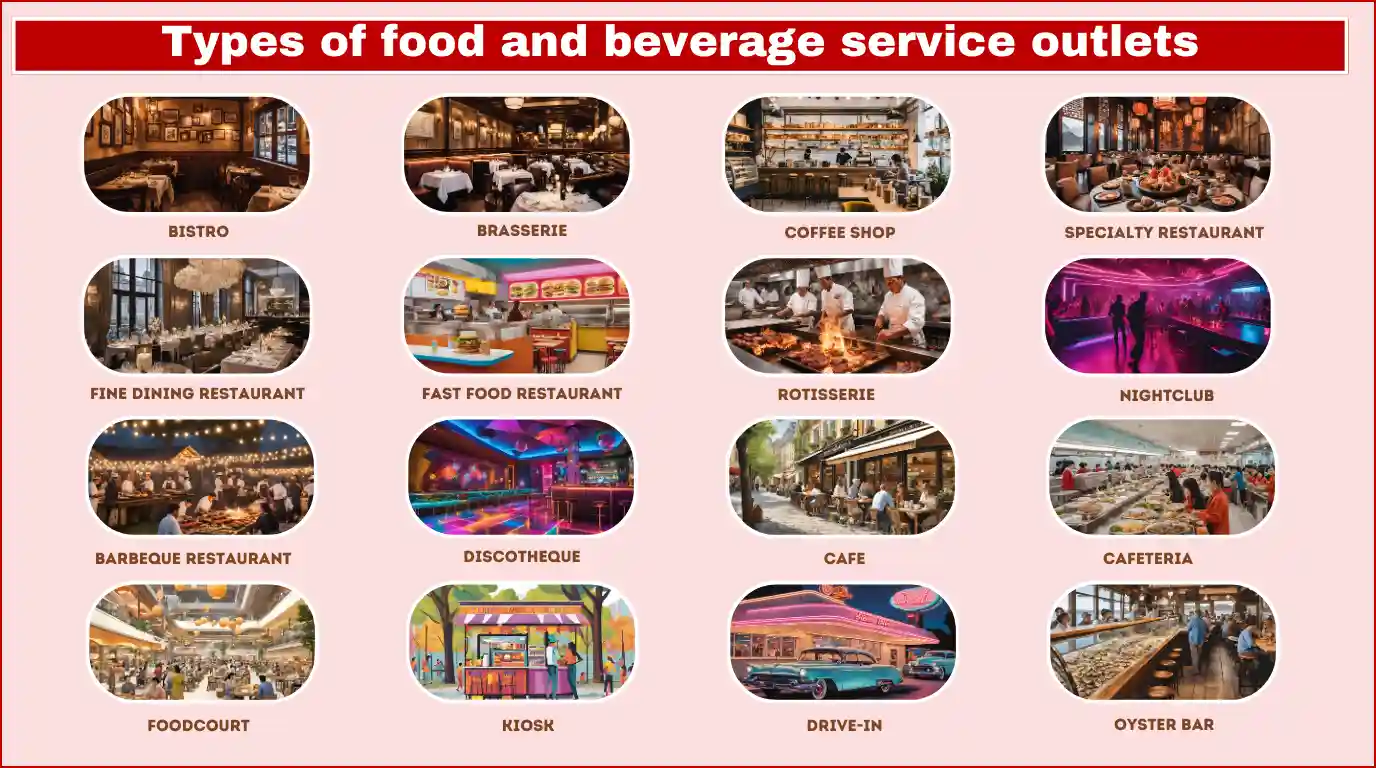The food and beverage (F&B) industry constitutes a significant segment of the global hospitality sector, offering a wide range of services designed to cater to the culinary and refreshment needs of guests. Within this domain, food and beverage service outlets play an essential role by providing diverse dining experiences, tailored environments, and varying service styles to meet the expectations of different clientele.
Understanding the various types of F&B outlets is critical for hospitality professionals, entrepreneurs, and service staff alike. This knowledge enhances operational effectiveness, improves customer satisfaction, and fosters innovation within the industry.
Detailed List of Food and Beverage Service Outlets:
In this section, we’ll explore the different types of food and beverage service outlets, providing a detailed breakdown of each. From formal dining experiences to casual spots and entertainment venues, we’ll cover a wide range of outlets and highlight their key features and operations.
I. Restaurants
Restaurants are the backbone of the food and beverage service industry, offering meals ranging from simple snacks to elaborate multicourse dinners. They vary considerably in service style, cuisine, and target market.
1. Fine Dining Restaurant
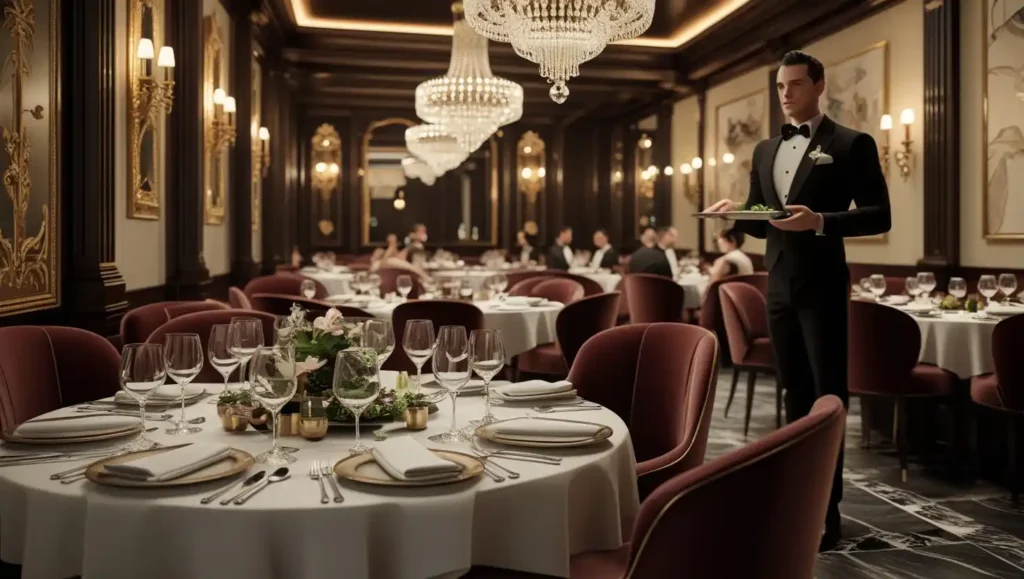
It is a food and beverage outlet offering high-end cuisine, formal service, and a sophisticated atmosphere. Fine dining restaurants are usually part of luxury hotels or upscale areas.
Fine dining began in 18th-century France, catering to aristocrats with refined service and elaborate meals, eventually spreading worldwide.
- Equipment: Luxurious furniture with fine linen, crystal glassware, and polished silverware. Formal covers with multiple utensils are laid out.
- Service: Classical-style (French, Russian, or American), formal, and attentive.
Menu: Gourmet multi-course meals with an extensive wine list.
Features: Formal dress code, reservations required, personalised service, and elegant décor.
2. Speciality Restaurant
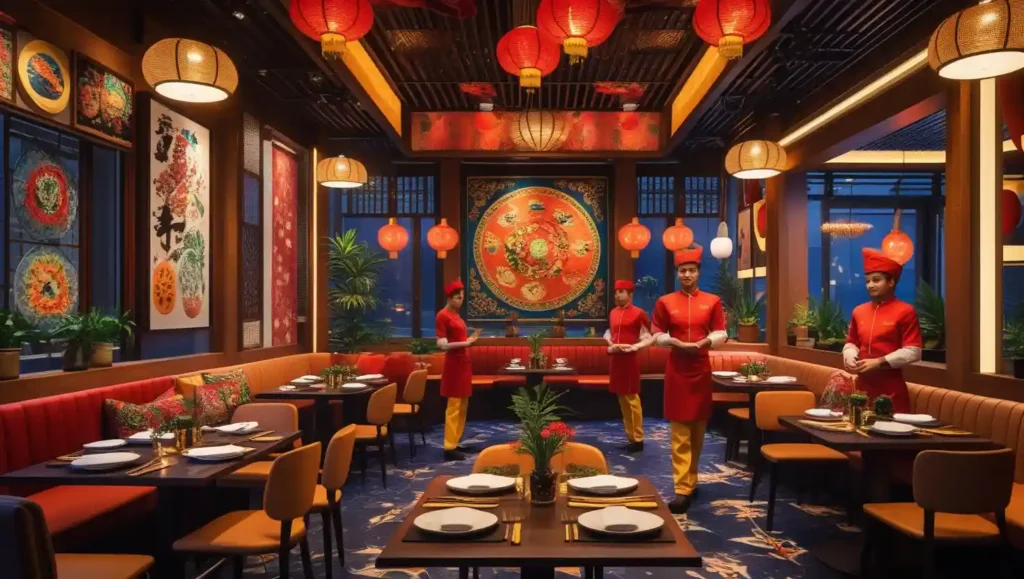
It is a food and beverage outlet that specialises in a particular cuisine or theme, offering an authentic experience through food, décor and service style. Service style complements the cuisine, often involving specialised techniques and presentation unique to the theme.
Speciality restaurants became popular with global travel, offering guests authentic tastes of different cultures in one location.
- Equipment: Décor, furniture, and table settings are carefully chosen to match the theme. Equipment and cutlery may vary based on the cuisine served.
- Service: Theme-based service, attentive and personalised.
Menu: Limited to a specific cuisine like Italian, Chinese, Indian, or seafood.
Features: Cultural décor, specialised culinary staff, authentic flavours, and themed ambience.
3. Bistro
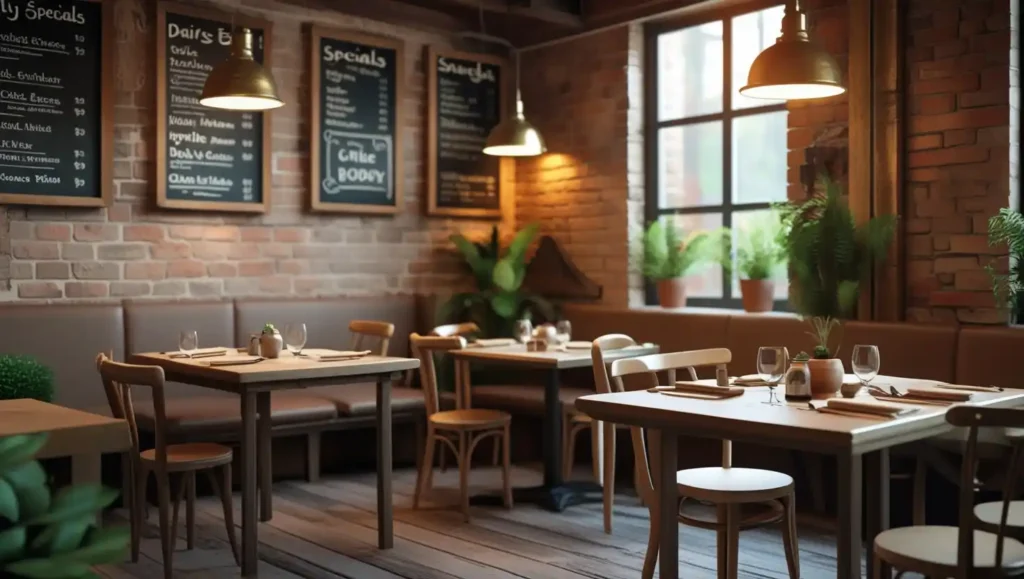
It is a small, casual food and beverage outlet offering simple, hearty meals at moderate prices, perfect for relaxed dining. Service is fast, friendly, and informal, focusing on efficiency without compromising quality.
Bistros originated in France, offering quick, home-style meals in a cosy, informal atmosphere for locals and travellers.
- Equipment: Simple wooden furniture, minimalistic table settings, and chalkboard menus create a warm, welcoming environment.
- Service: Informal and quick.
- Menu: Hearty, simple meals with daily specials.
- Features: Cosy atmosphere, speedy service, and affordable pricing.
4. Brasserie
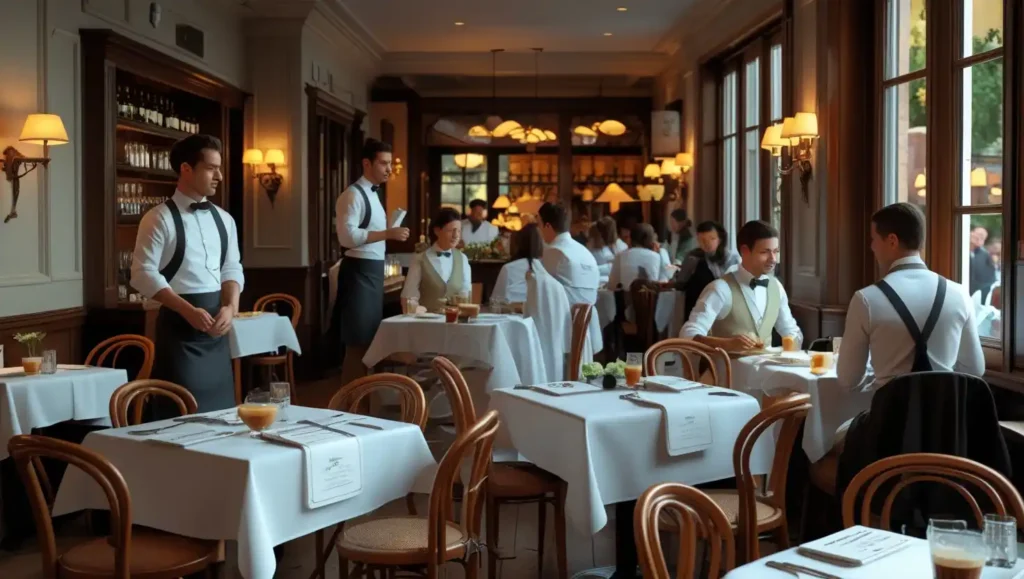
It is a formal food and beverage outlet that serves drinks, single dishes, and full meals in a casual yet polished environment. Guests can stop in for a coffee, a drink, or a full meal. Service is professional, with printed menus and attentive waitstaff providing consistent hospitality throughout the day.
The term “brasserie” comes from the French word for “brewery,” first used in English in 1864. In France and French-speaking regions, brasseries offer a relaxed but professional dining experience.
- Equipment: White linen tablecloths, simple, elegant furniture, printed menus, and traditionally uniformed waitstaff with long aprons and waistcoats.
- Service: Formal yet relaxed.
- Menu: Consistent all day; often featuring dishes like steak and fries.
- Features: Professional service, white linen setup, relaxed but elegant atmosphere, open daily.
5. Rotisserie
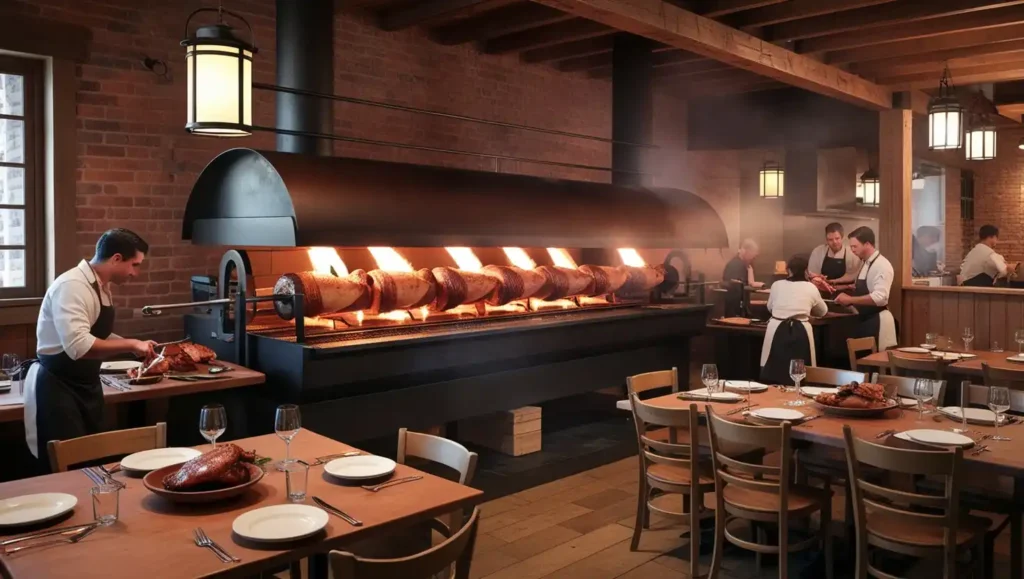
It is a food and beverage outlet specialising in slow-roasted or spit-cooked meats, offering flavorful, hearty meals in a rustic, inviting atmosphere.
The concept of rotisserie cooking dates back to medieval Europe, where meats were slowly roasted over open fires for tenderness and flavour.
- Equipment: Open kitchen or visible roasting area featuring rotating spits, simple wooden furniture, and hearty table settings.
- Service: Informal and friendly, with an emphasis on quick service and generous portions of roasted meats.
- Menu: Roasted meats like chicken, beef, and pork, with hearty sides.
- Features: Visible roasting area, rustic ambience, and a focus on flavorful, slow-cooked meals.
6. Barbecue Restaurant

Barbecue restaurants specialise in grilled, smoked, or pit-cooked meats, offering bold flavours and hearty portions. These venues typically embrace a casual, relaxed atmosphere, making them a favourite choice for group gatherings, family outings, and outdoor dining experiences.
Key Features:
- A menu focused on grilled and smoked meats, accompanied by classic sides like coleslaw, baked beans, and cornbread.
- Informal, laid-back service style to match the casual dining environment.
- Many barbecue restaurants feature outdoor seating areas, enhancing the rustic and open-air feel of the experience.
Barbecue establishments celebrate slow-cooked techniques that bring out rich, smoky flavours, with cooking often done over wood or charcoal fires for authentic taste. Whether it’s ribs, brisket, pulled pork, or grilled chicken, barbecue restaurants deliver comfort food packed with tradition and flavour.
Want to learn restaurant’s service procedure? Read: Sequence of Service in Restaurants: Steps of Table Service in Fine Dining
II. Casual and Quick Service Outlets
Casual and quick service outlets are designed for speed, convenience, and a relaxed dining atmosphere. They appeal to a broad customer base seeking affordable and efficient food service experiences.
7. Coffee Shop
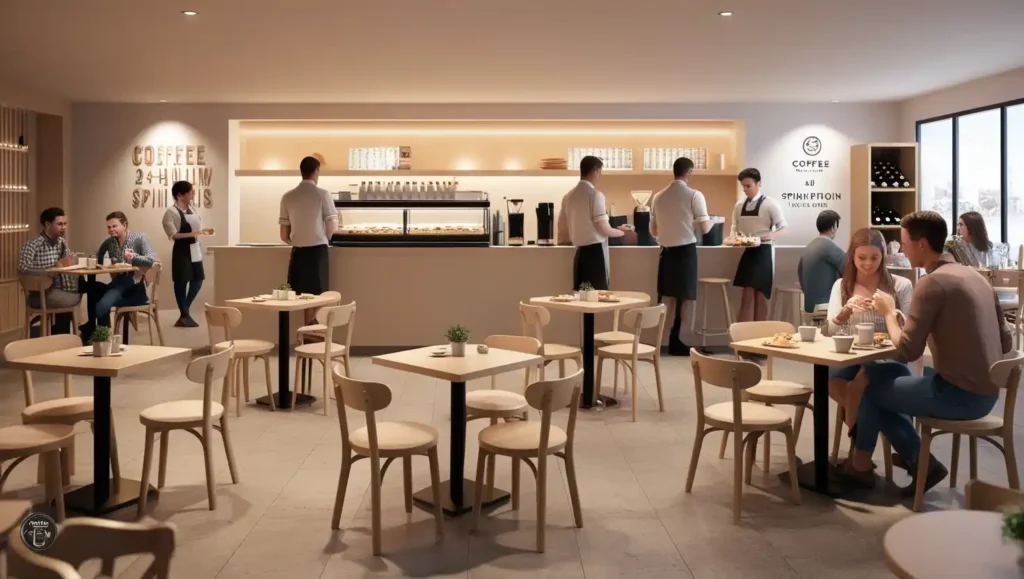
A coffee shop is a casual food and beverage outlet, mainly serving snacks, beverages, and light meals. Found commonly in star hotels, they often operate 24 hours to meet guests’ needs at any time.
The modern coffee shop concept originated in the U.S., while the word “café” comes from French, Spanish, and Portuguese roots, adopted into English in the late 19th century.
Setup and Service: Furniture is simple and functional, with basic table settings. Service is informal and American-style (pre-plated), focusing on speed and convenience. Many hotel coffee shops also serve wines and spirits.
Key Features:
- 24-hour operation
- Quick, informal service
- Affordable pricing with high seat turnover
- The menu focused on snacks, beverages, and light meals
8. Café

A café is an F&B outlet of French origin, predominantly serving coffee and light snacks. The concept of the café was introduced by the French in their colonies, and in India, it often includes local snacks such as vada, samosa, and bonda, along with traditional coffee and pastries. Many cafés in southern India still carry this heritage in their offerings.
- Menu: Sandwiches, burgers, pastries, and beverages.
- Service: American-style table service; low revenue per cover.
- Dishes: A mix of Indian snacks, sandwiches, burgers, pizzas, pastries, and beverages.
Cafés typically offer American-style service at tables, promoting quicker seat turnover. However, the average revenue per cover tends to be lower due to the affordable pricing of dishes.
9. Fast Food Restaurant
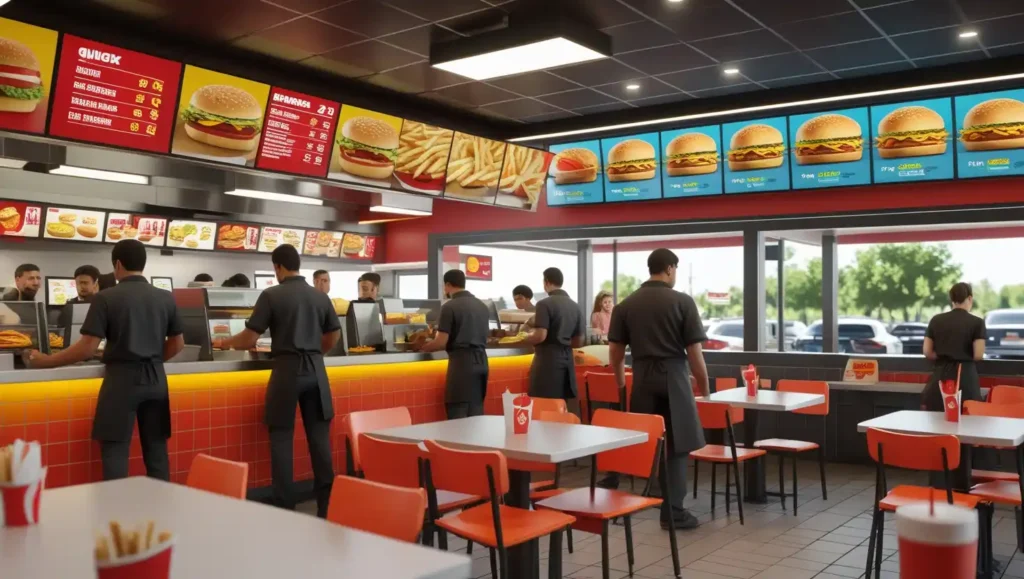
Fast food restaurants are known for their quick service, standardised menus, and budget-friendly pricing. The menu typically includes burgers, fries, and soft drinks, designed to cater to busy customers seeking quick meals. They often include counter service, and many offer drive-thru facilities for convenience.
- Menu: Burgers, fries, soft drinks, and other fast food items.
- Service: Quick counter service with optional drive-thru.
- Dishes: Standardised fast food items like burgers, fries, fried chicken, and soft drinks.
Fast food restaurants focus on speed and efficiency, with high seat turnover. The quick service model and affordable pricing are key features that appeal to families, travellers, and busy individuals.
10. Cafeteria
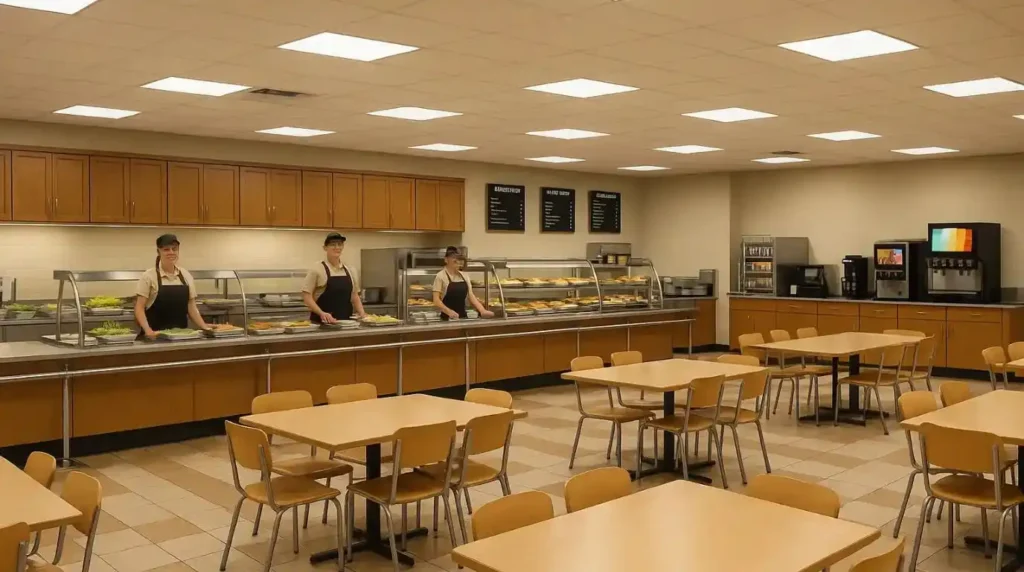
Cafeterias operate on a self-service model, offering a wide selection of meals that customers choose from various food counters before paying at the cashier. These outlets are commonly found in schools, hospitals, corporate offices, and other institutional settings, providing an efficient solution for large crowds.
- Menu: A wide variety of meals, snacks, and beverages.
- Service: Self-service, efficient, and fast-paced.
- Dishes: A variety of hot and cold meals, salads, sandwiches, and beverages.
Cafeterias cater to large volumes of people, offering a quick and practical dining experience. The focus is on efficiency, with functional interior design to handle high traffic.
11. Food Court
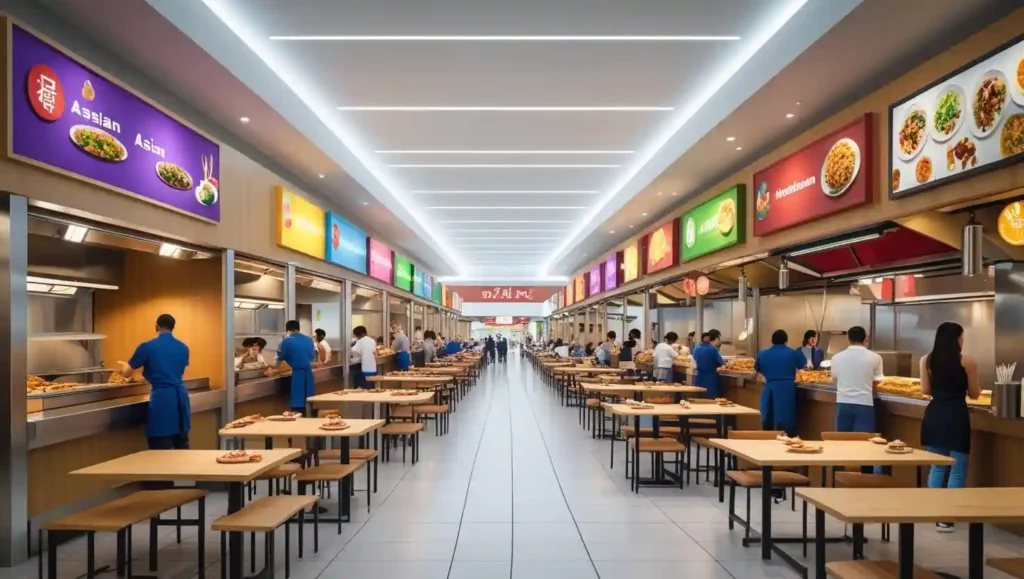
Food courts are spacious areas that house multiple food vendors, each offering a variety of cuisines under one roof. Typically located in shopping malls, airports, and large public spaces, food courts cater to diverse dining preferences, making them popular for group dining.
- Menu: A wide range of cuisines and meal options from various vendors.
- Service: Informal, fast service with self-ordering at each stall.
- Dishes: A variety of cuisines, including Asian, Mediterranean, fast food, and desserts.
Food courts offer diverse choices in one location, making them ideal for groups with different tastes and preferences. Centralised seating encourages social dining, and the quick service model ensures high seat turnover.
12. Kiosk
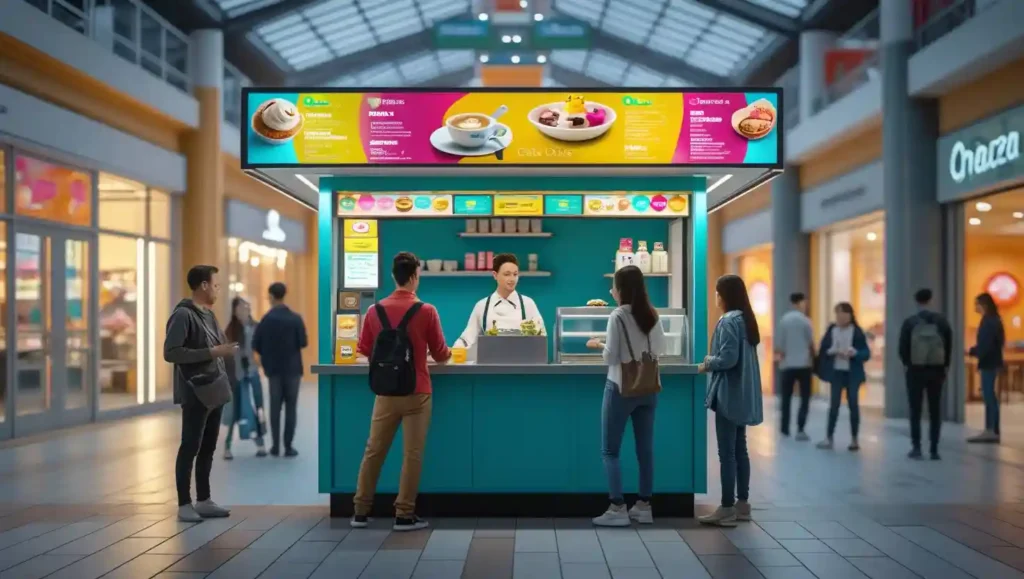
Kiosks are small, stand-alone outlets that specialise in a limited range of food and beverages, usually targeting impulse buyers in high-footfall areas like malls, parks, or airports. These outlets focus on quick service with minimal seating, often geared towards takeaway.
- Menu: Snacks, coffee, ice cream, and beverages.
- Service: Fast service with minimal seating.
- Dishes: Quick snacks like coffee, ice cream, pastries, and light bites.
Kiosks are designed for convenience, offering fast, easily consumable items to customers on the go. Their strategic placement in high-traffic areas ensures they attract plenty of impulse buyers.
13. Drive-In
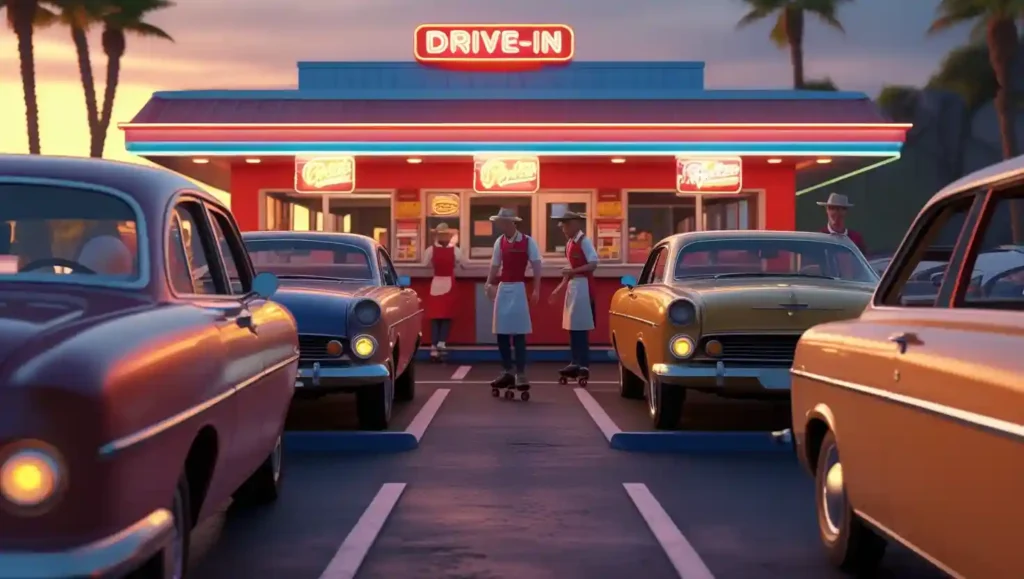
Drive-ins are food outlets where customers place orders and receive their meals directly in their vehicles. Popular in suburban areas, drive-ins are designed for convenience, catering to customers who prefer to eat in their cars, especially families and travellers.
- Menu: Quick, easy-to-eat meals such as burgers, fries, and shakes.
- Service: Car-side service, quick meal delivery.
- Dishes: Simple, portable meals like burgers, fries, hot dogs, and soft drinks.
Drive-ins focus on efficiency and convenience, offering quick, easy meals that customers can enjoy without leaving their vehicles. The service is fast, ideal for families or travellers seeking a hassle-free dining experience.
III. Bars and Entertainment Outlets
Entertainment-focused F&B outlets combine food and drink services with recreational experiences. These venues often operate during late hours and create vibrant social environments.
14. Bar

Bars specialise in serving alcoholic drinks, particularly cocktails, beers, and wines, often paired with light snacks like nuts or chips. The environment can range from casual neighbourhood spots to sophisticated cocktail lounges, providing a relaxed atmosphere.
- Menu: Cocktails, beers, wines, light snacks.
- Service: Informal service, often with a bartender preparing drinks.
- Dishes: Light snacks, appetisers, and finger foods.
Bars are known for their relaxed seating and ambient lighting, often featuring entertainment like live music or televised sports.
Learn more about bars:
- Types of Bars: A Complete Guide for Hospitality Professionals
- 46 Essential Bar Equipment and Tools List and Their Use
15. Pub
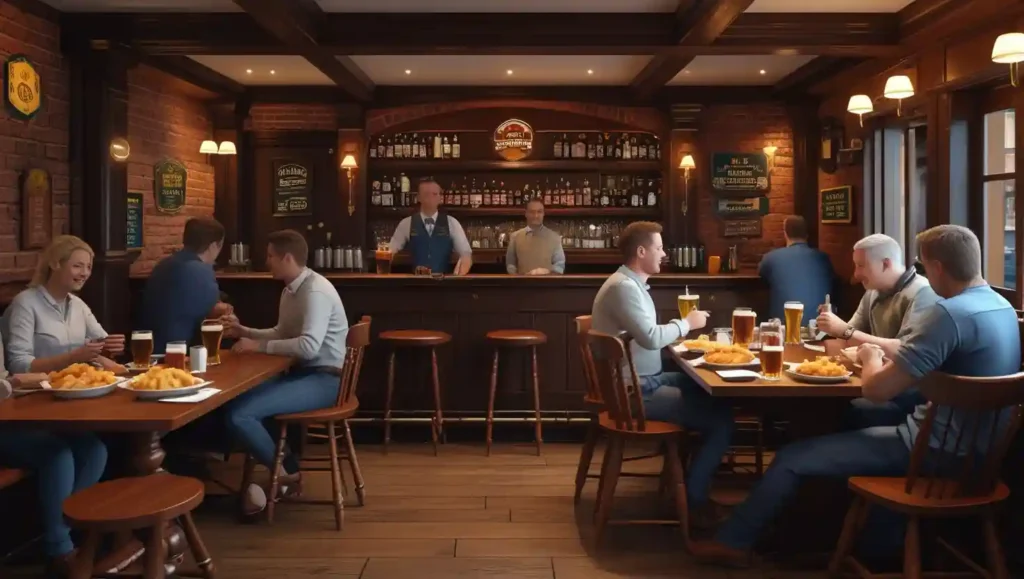
Pubs, short for “public houses,” serve comfort foods alongside a wide variety of alcoholic beverages. Known for their rustic interiors and welcoming environment, pubs are great for both dining and socialising, with a focus on beers, ales, and spirits.
- Menu: Comfort foods like pies, fish and chips, and burgers.
- Service: Casual service, often at the counter or table.
- Dishes: Hearty meals and traditional British fare.
Pubs provide a relaxed, communal vibe with an emphasis on good food, drinks, and social gatherings.
16. Oyster Bar
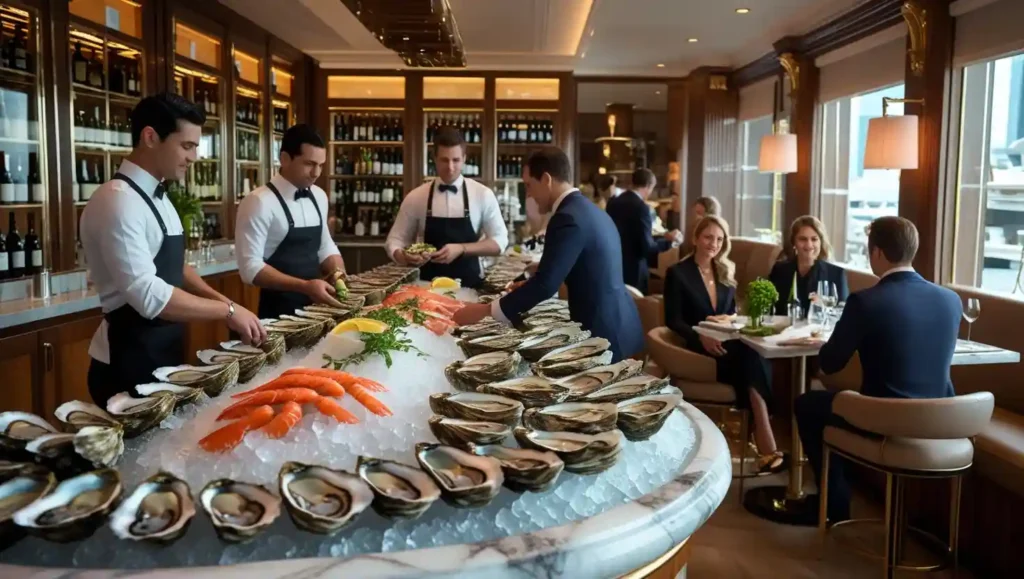
Oyster bars specialise in serving fresh oysters and other shellfish, often paired with fine wines and champagnes. These outlets offer an upscale and sophisticated dining experience, ideal for seafood lovers.
- Menu: Fresh oysters, shellfish, seafood platters.
- Service: Professional, often with an emphasis on presentation and beverage pairings.
- Dishes: Fresh seafood, oysters, shellfish, caviar.
The ambience is upscale, with a focus on quality and refinement, making it a perfect spot for special occasions.
17. Nightclub
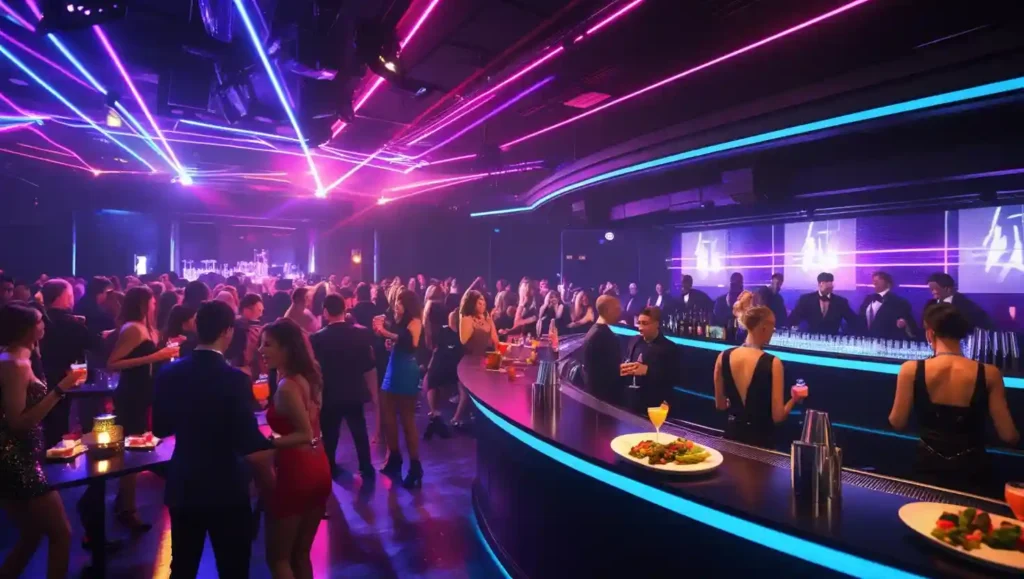
Nightclubs provide a high-energy entertainment experience with music, dancing, and live DJ performances. While food is typically limited, the focus is on drinks, often with premium pricing for cocktails and spirits.
- Menu: Beverages, limited food offerings (usually snacks).
- Service: Fast-paced, drink-focused service.
- Dishes: Mostly drinks with occasional finger foods.
Nightclubs operate late into the night, catering to partygoers and those seeking a dynamic entertainment environment.
18. Discotheque

Discotheques are a type of nightclub with an even stronger emphasis on the dance floor and music experience. The focus is on high-energy music, flashing lights, and serving cocktails and bottled beverages, with minimal food options.
- Menu: Beverages, mainly cocktails, and bottled drinks.
- Service: Informal, focused on quick drink service.
- Dishes: Limited, usually snacks or finger foods.
The environment is energetic and music-centric, catering mostly to youth and partygoers looking for a vibrant dance atmosphere.
IV. Speciality and Event-Based Outlets
Speciality and event-based outlets cater to specific customer needs, occasions, or dining preferences.
19. Carvery
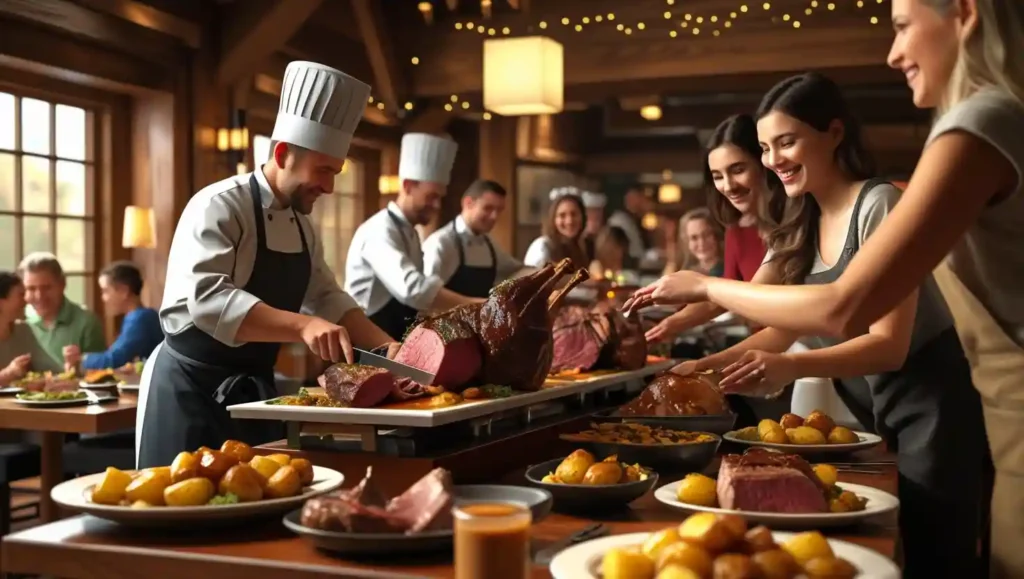
Carveries specialise in roasted meats, often including a variety of beef, lamb, and poultry. Guests can select their preferred cuts, typically served in a buffet or assisted-service style. These outlets operate in casual to semi-formal settings.
- Menu: Roasted meats (beef, lamb, poultry), vegetables, and sides.
- Service: Buffet or assisted-service, where meats are carved and served to guests.
- Dishes: Roast meats with traditional sides like potatoes, vegetables, and sauces.
The carvery concept is popular for gatherings and family meals, providing guests with the freedom to select their preferred meat and sides.
20. Banquet Hall
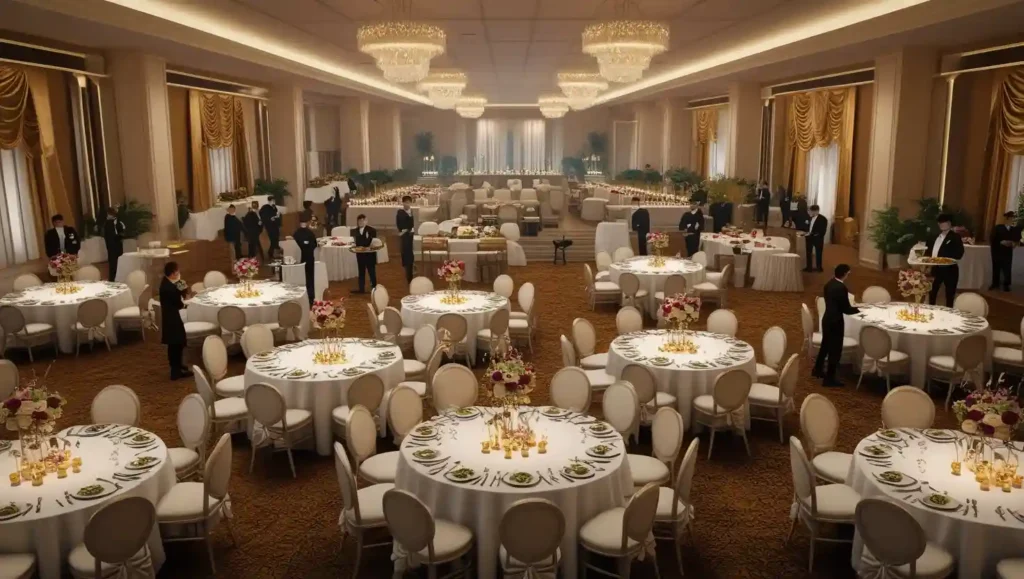
Banquet halls are venues designed to host large events, offering flexible seating and menu arrangements tailored to the specific event. These halls are perfect for weddings, corporate functions, and social gatherings.
Menu: Customised menus based on event requirements (buffet or plated service).
Service: Coordinated with event management teams, ensuring smooth service for large groups.
Dishes: A variety of dishes, often buffet-style or plated meals, depending on the event.
Banquet halls are versatile spaces, providing both a beautiful setting and a personalised dining experience for guests.
21. Lounge.
Lounges provide a calm and comfortable setting where guests can enjoy light refreshments and beverages. Common in hotels and airports, lounges offer a refined and exclusive atmosphere for relaxation.
- Menu: Light meals, beverages, and sometimes a buffet.
- Service: Relaxed and often self-service or attended service.
- Dishes: Light bites like sandwiches, salads, and pastries.
Lounges are ideal for those looking for a peaceful, exclusive environment to unwind, often with added comfort for business meetings.
22. Poolside Outlet
Poolside outlets are typically found in resorts and luxury hotels, providing food and drinks to guests relaxing by the pool. The menu features light, refreshing meals and beverages.
- Menu: Light meals, tropical cocktails, and snacks.
- Service: Outdoor, casual service, often with poolside seating.
- Dishes: Tropical drinks, finger foods, salads, and sandwiches.
The focus is on casual, relaxed dining to complement the leisure atmosphere by the pool.
23. In-Room Dining / Room Service
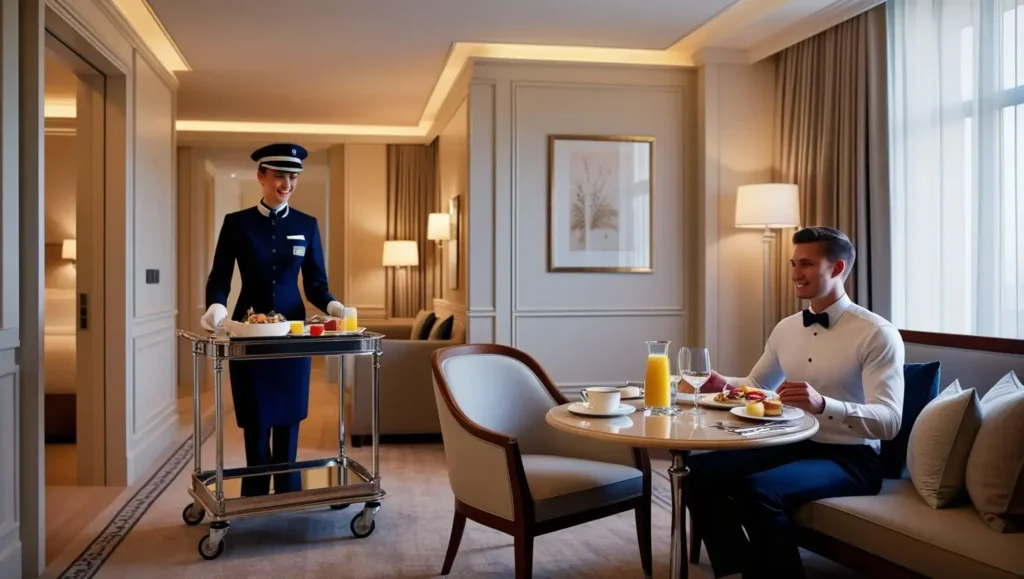
In-room dining or room service allows hotel guests to enjoy meals in the privacy of their rooms. It is available 24/7 in luxury hotels, with customised menus featuring comfort foods and more.
- Menu: Comfort foods, à la carte options, and special menus based on guest preferences.
- Service: 24/7 availability with discreet and timely delivery to guest rooms.
- Dishes: A variety of dishes, often comfort foods, breakfast items, snacks, and beverages.
Room service emphasises convenience and discretion, providing high-quality dining in the comfort of a guest’s room.
Conclusion
Food and beverage service outlets play a vital role in the hospitality industry, offering a wide range of experiences to suit diverse customer needs. Understanding the various types and their operations is key for hospitality professionals to deliver exceptional service and stay competitive. As trends evolve, focusing on innovation, sustainability, and customer satisfaction will be essential for success in this dynamic sector.
Also Read:
This article was written by Saswata Banerjee, the creator of Food and Beverage Service Knowledge, based on 8+ years of experience in the hospitality industry.

